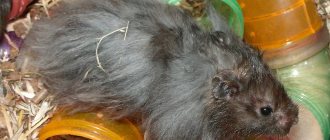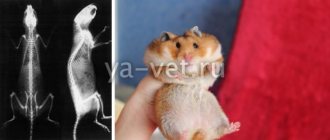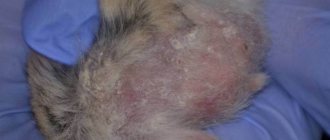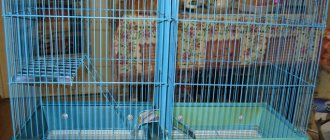Some diseases of Djungarian hamsters are dangerous to humans, so the pet owner must quickly respond to their manifestations. You can’t delay either because diseases in small rodents progress rapidly.
Let's find out what diseases are most common in jungarians, how to recognize them and what to do before visiting the veterinarian.
What do hamsters, “jungarians” and their Syrian brothers get sick with?
The most common ailments for domestic rodents are mechanical injuries (dislocations, fractures, bruises), metabolic disorders and disorders of the digestive system associated with a violation of the animal’s diet.
Hamsters can get sick from both infectious (viral, bacterial and parasitic) and diseases not associated with an infectious agent. Including oncological pathologies. Hamsters may have helminths and intracellular parasites, lice, fleas, ticks, and skin fungus, but most likely you will not have to encounter these diseases if you follow the rules and regulations for caring for animals.
The most common pathologies in hamsters
The most common ailments for domestic rodents are:
- mechanical injuries (dislocations, fractures, bruises), including those received by an animal from squeezing a loving owner;
- metabolic disorders (obesity);
- disorders of the gastrointestinal tract associated with violation of the animal’s diet;
- abscesses on the paws;
- respiratory ailments of a viral and bacterial nature caused by a weakening of the general resistance of the animal’s body (hypothermia, drafts, vitamin deficiency);
- eye diseases (conjunctivitis: traumatic, allergic, associated with respiratory infection);
- diseases of the oral cavity and teeth (anomalies, excessive growth of teeth, inflammation of the cheek pouch).
With careful attention to your pet and good care for it, most diseases can be avoided.
Diseases dangerous to humans
Diseases that can be dangerous or potentially dangerous to humans are classified as infectious.
A person can become infected:
- rabies (the risk that a domestic hamster will be bitten by an infected predator is minimal);
- tularemia;
- salmonellosis;
- lymphocytic choriomeningitis (in most cases, people are asymptomatic);
- campylobacteriosis;
- helminthiasis called hymenolepiasis (only one type of helminth is dangerous for people - the dwarf tapeworm);
- dermatomycosis;
- tuberculosis;
- plague;
- leptospirosis and some others.
If you purchase an animal from well-established breeders and follow all animal hygiene measures, the risk of developing any of the listed diseases in a pet kept in an apartment is not very high.
Symptoms and signs of diseases of hamsters - regular, Djungarian, Syrian
The hamster is losing a lot of weight, he is lethargic and refuses to play. Moves slowly, sometimes staggering and with difficulty. Refuses food, sometimes drinks, or drinks a lot. Sits hunched over, eyes half closed. The coat looks disheveled, greasy, or falls out in clumps, forming tangles.
The owner may also notice:
- unpleasant odor from the pet;
- bowel dysfunction (constipation/diarrhea);
- various elements of a rash appear on the skin (from blisters to crusts);
- the hamster's eyelids stick together or the eyes lose their shine and transparency, become cloudy with a whitish veil, and protrude;
- the animal is limping;
- breathing heavily, coughing or sneezing;
- there is discharge of mucus, pus or serous and bloody discharge from the eyes, mouth, genitals;
- torticollis;
- constant itching;
- wet fur near the anus or around the muzzle;
- cheek pouches fall out;
- The animal is losing a lot of weight or gaining weight.
Any of these signs is a reason to contact a veterinarian. Some owners are embarrassed to come to the veterinary clinic with their animals. If your pet’s life is precious, you should definitely take him to a veterinarian.
How to understand that your pet is sick
An attentive owner will definitely notice that the hamster is sick. Due to poor health, the appearance and behavior of the animal changes.
Signs of illness are:
- a sick hamster does not come to the feeder and even refuses his favorite treat;
- the fur becomes unkempt, greasy and disheveled;
- your pet sleeps more than usual; at night, when rodents are active, he does not leave the house, does not want to run in a wheel;
- due to illness, the Djungarian hamster behaves aggressively: it is irritated by sounds, light, and the attention of the owner;
- while awake, the pet looks lethargic and moves slowly;
- a wet face is a sign of respiratory tract disease;
- scratches, bald spots or wounds on the body;
- change in consistency and color of droppings; liquid and foul-smelling feces are a sign of gastrointestinal disease;
- nasal discharge;
- wet or sticky eyelids, cloudy eyes;
- wet fur under the tail indicates diarrhea;
- the naked eye can see that the Djungarian hamster is losing weight; a healthy animal should not weigh less than 30 g;
- while eating, food falls out of the mouth;
- the hamster breathes frequently, shallowly and at the same time wheezes;
- increased belly;
- slight trembling;
- bloody discharge under the tail.
Oral and dental diseases
Dental problems
Hamsters experience constant growth of their incisors. If an animal does not have enough objects on which to grind its teeth, it must suffer from excessive growth. This is manifested by hypersalivation, refusal of food, and weight loss of the pet.
Pathologies of the cheek pouches
Owners encounter this disorder in hamsters quite often.
The most common problems are:
- prolapse/prolapse;
- injuries;
- abscesses;
- neoplasms.
Signs of the disease are the appearance of pink tissue in the corner of the hamster's mouth due to prolapse. In case of injuries and abscesses, the hamster's eyes become very watery. At the initial stage of tumor formation, the animal may not have any symptoms. The cause of their appearance is unknown; treatment is surgical.
Obesity
Hamsters are extremely active animals. In nature, they have their own grounds, which they run around every night. During the night they run many kilometers in search of food. If a hamster is deprived of the opportunity to lead an active lifestyle, he may well become obese. What diseases can a hamster develop as a result of obesity? Problems with the cardiovascular system, fatty liver, problems with the kidneys and other internal organs.
To avoid obesity, you should strictly monitor compliance with the standards for keeping your hamster. First of all, he must have a cage of the correct size:
- for the Djungarian hamster the bottom is greater than or equal to 50*30 cm;
- for the Syrian hamster the bottom is greater than or equal to 60*40 cm.
A hamster must have a wheel in its cage. Short walks with the owner will not replace a long and energy-consuming run in a wheel, to which the hamster’s instincts push it. A small wheel is not useful, and even dangerous for a hamster. Using a wheel that is too small can cause spinal curvature in larger species, which can cause Syrian hamsters to develop illnesses that cannot be treated.
Wheel size standards:
- for a dwarf hamster - with a diameter of 16 cm;
- for a Syrian hamster - with a diameter of 18 cm.
Another cause of obesity may be poor quality food. When choosing food for your hamster, be sure to familiarize yourself with its composition. Most of the cheap food sold in pet stores is extremely low quality. Your hamster's diet should also include vegetables and fruits. Protein supplements are also important: dried insects, egg whites, chicken fillet boiled without seasoning. You shouldn’t skimp on your pet’s health; you need to buy high-quality food recommended by breeders.
Eye diseases
Conjunctivitis
Most often, owners encounter conjunctivitis in pet hamsters. It can be triggered by an infectious disease (salmonellosis, pseudotuberculosis, infectious pneumonia), injuries, debris and allergies.
In this case, the hamster squints the affected eye, its eyelids swell, photophobia develops, and the mucous lining is inflamed. The eyes become watery and a purulent secretion is released. If left untreated, the inflammatory process can also affect the cornea of the eye.
Cataract
Cloudiness of the lens in hamsters can be congenital, diabetic, or traumatic. Visually, the clouding is noticeable through the pupil, in the form of a whitish spot. In this case, the animal moves uncertainly, due to decreased vision or its complete loss.
Metabolic disorders
Do you know what hamsters get sick with besides viral, fungal and cold infections? Some individuals experience metabolic disorders. Sometimes they are hereditary, but sometimes humans are also to blame, as is the case with diabetes mellitus among the Djungarians.
Diabetes
Interestingly, the symptoms of diabetes in hamsters are the same as in humans:
- irrepressible thirst and increased appetite;
- sharp fluctuations in weight (quickly losing weight or getting fat);
- physiological fluids smell like acetone (urine, saliva);
- increased interest in the wheel: the animal is able to spin it longer than usual without stopping.
Diabetes mellitus is diagnosed using a laboratory blood test - checking glucose levels. After the diagnosis is established, drug treatment and a diet with a high protein content and a small amount of “fast” carbohydrates are prescribed.
Stroke
Metabolic diseases also include vascular diseases that occur in old age. Stroke in hamsters is often caused by the deposition of cholesterol plaques in the vessels of the head (that is, lipid metabolism is impaired). When the plaque completely covers the lumen of the vessel, blood accumulates, and the walls of the vein or artery stretch under its pressure. But they cannot stretch forever, the vessel bursts and hemorrhage occurs.
Stone disease
Stone disease is a very dangerous condition for hamsters. It occurs when salt metabolism is disrupted, as a result, sand gradually accumulates in the kidneys, bladder and bile ducts, combining into pebbles. When the stone moves, it causes hellish pain, the hamster screams heart-rendingly. Also, with this disease, the hamster's tail is tucked, the animal rarely pees, and there is blood in the urine. In small rodents the disease is not treated.
Obesity
In nature, hamsters are in a state of perpetual motion. And in our home they are often deprived of many active activities. There is a particularly high risk of decreased activity due to obesity, which can lead to even more dire consequences. After all, obesity is the first path to cardiovascular diseases and muscle atrophy. To avoid problems, carefully monitor your pet’s diet and make sure that his cage has enough “horizontal bars” for exercise: a running wheel, ladders, free space, tunnels. Let the animal out for a free run more often, the main thing is to carefully ensure that it does not run anywhere and get hurt.
Obesity, like urolithiasis, is typical for mature hamsters. It occurs infrequently in active dwarf hamsters (unless accompanied by diabetes); Syrian hamsters have a greater predisposition.
The photo shows an obese hamster.
Polycystic ovary syndrome
Polycystic ovary syndrome is a hormonal disorder in hamsters. The main cause of hormonal imbalances is frequent childbirth. At the same time, the hamster becomes lethargic, irritable, and her tummy is slightly swollen, bowel movements are irregular. It is possible to cure a female, but it cannot be done without surgery.
Hormonal changes coupled with poor nutrition can cause hemorrhoids in a hamster. This is a painful condition in which it is painful for the animal to defecate; in the hamster, blood can be seen on the fur under the tail.
Diseases of the gastrointestinal tract of hamsters
In these animals, pathologies of the digestive system occur with diarrhea or constipation, strong rumbling along the intestines, bloating and pain. In this case, the stool is not only liquid, but also with an unpleasant odor, and may contain an admixture of blood, mucus, or undigested lumps of mucus.
Improper feeding
Most often, hamsters suffer from non-infectious enteritis associated with poor diet, most often with a lack of hay. In this case, animals may experience constipation, diarrhea, flatulence, loss of appetite and lethargy.
Stress
Stool upset in hamsters can be caused by severe stress. There is no need to pick up the animal, just let it calm down. This condition does not require treatment.
Salmonellosis
An infectious disease of a bacterial nature, manifested by loss of desire to eat and severe diarrhea.
Hamster feces are slimy, foamy, and sticky. It acquires a yellow and green color and a very unpleasant odor.
The animal sits huddled in a corner and practically does not move.
His eyes turn sour (conjunctivitis begins), his stomach swells from gases and his spleen enlarges. The temperature rises sharply and then drops below normal levels. The animal dies within a week.
Colibacillosis (escherichiosis)
The hamster practically does not move, is apathetic, has no appetite, and weakness of the lower extremities is noticeable. The animal is suffering from diarrhea. The stools are liquid with a very unpleasant odor, light yellow, sometimes mixed with blood. The animal usually dies.
Wet tail
An infectious disease, the main symptom of which is watery diarrhea and constantly wet hair around the anus. Then the hamster becomes irritable, refuses food, and begins to bleed rectally. You need to give the animal water with electrolyte solutions and be sure to show the hamster to a doctor.
Poisoning
Signs of poisoning depend on what substance the animal sniffed, licked or swallowed. And from its quantity. This may include vomiting and diarrhea, loss of appetite and thirst, lethargy, and coordination disorders.
Coccidiosis
A parasitic disease, when the body’s defenses are weakened, active reproduction of coccidia (intracellular parasites) begins, leading to enteritis. The disease is characterized by bloody diarrhea and exhaustion of the animal. The hamster dies in most cases.
Parasitic, fungal, dermatological
Regardless of breed characteristics, hamsters are susceptible to fungal and parasitic diseases. Djungarians are often diagnosed with lichen, trichomoniasis and dermatophytosis. Animals are often attacked by worms. As a result of the development of such diseases, pets experience severe itching, restlessness and deterioration of the coat. Scratches, wounds and rashes form on the body.
Hamsters are susceptible to parasitic diseases.
With dermatophytosis, the skin becomes yellowish and begins to peel off. In the absence of effective treatment, pathogenic microorganisms penetrate into the lesions, provoking the development of inflammation in the structures of the dermis.
In addition, hamsters are vulnerable to dermatitis, dermatosis and allergic reactions. With a deficiency of vitamins and minerals, the condition of the coat worsens, and the protective functions of the immune system are reduced.
Diseases of the skin, fur and claws
Alopecia
There are many reasons for hair loss that is not associated with seasonal shedding in animals.
Usually this:
- stress;
- lack of nutrients;
- inflammatory diseases of the gastrointestinal tract;
- parasitic and fungal infections.
For any reason of illness, the animal needs to ensure a quiet existence, harmonize and fortify the diet.
In case of ringworm or parasitic infections, specific treatment is required.
Dermatomycoses
Most often these are microsporia and trichophytosis. With fungal infection of the skin and fur, the animal not only loses its hair, the hairs look broken at the root, sores and crusts appear on the skin. The animal is bothered by severe itching.
Dermatitis
Hamsters can have an allergic reaction, for example, to bedding. It is manifested by skin itching, tissue hyperemia, the appearance of various elements of the rash, and scratching.
Parasites
Helminthiasis can lead to deterioration in wool quality. Parasitism of lice and fleas leads to skin itching, tissue damage, and the formation of tangles.
Mouse pox
This disease is more common in rats and mice, but sometimes hamsters are also infected. In the acute course of the disease, the animal dies with minimal symptoms. With a less pronounced process, the hamster’s paw swells, closer to the sole, and blisters form on the skin. The paw hurts greatly, the process ends with gangrene and loss of the limb.
Drugs used to treat rodents
Some medications are dangerous for the body of hamsters, so it is better to avoid using them. Among them are Penicillin, Ampicillin, Gentamicin and cephalosporins. It is forbidden to use antibiotics without consulting a veterinarian.
To strengthen the body, pets are given vitamin tablets and liquid concentrates.
Fungal infections are treated with the following drugs:
- Triderm.
- Fluconazole.
- Ketoconazole.
- Griseofulvin.
Respiratory diseases
Trichomoniasis
This is an infectious disease characterized by the formation of yellow plaque and swelling of the pharynx, respiratory failure and laryngospasm. This condition leads to difficulty both breathing and eating. The hamster is losing weight and may fall.
Lymphocytic choriomeningitis
An infectious disease in rodents that cannot be treated. When this pathology is diagnosed, it is recommended to euthanize the animal.
The disease manifests itself:
- increased body temperature;
- breathing problems;
- lethargy and weakness of the pet.
The main carriers of the pathogen are mice and rats. Therefore, if the animal is kept in a room attacked by mice or on the street, it is necessary to make it difficult for mice and rats to access the hamster's cage.
Respiratory infections
The influenza virus and other respiratory infections can be transmitted from hamsters to humans and back. The disease is accompanied by sneezing, coughing, lacrimation, and rhinitis. The disease can develop against the background of hypothermia or severe stress.
Diplococcal infection
This disease occurs with high fever, severe rhinitis, wheezing, cough, and loss of appetite. The animal loses weight, visible mucous membranes become pale. A few days later the hamster dies.
Infectious pneumonia
A bacterial infection that occurs with loss of desire to eat, inability to move, and difficulty breathing. At the same time, the hamster’s mucous membranes acquire a bluish tint, he coughs, gurgling is heard in the lungs, and conjunctivitis develops.
Caring for a sick pet
During illness, in addition to treatment, the Djungarian hamster needs the care and attention of the owner.
Maintaining the right microclimate
The cage with a sick Djungarian hamster should be placed in a quiet room. It is important to protect it from direct sunlight and drafts. The room should not be too hot or cold. The suitable temperature for keeping a rodent is +22…+25 degrees.
Due to general malaise, the hamster's body temperature may drop. A heating pad or a bottle of warm water will help warm it up. It needs to be placed in a cage and covered with a towel. You can put your pet on it for the first time. When he feels the source of heat, he himself will understand that he needs to stay closer to it.
Maintaining water balance
If a sick dzhungarik refuses to eat and drink, this threatens dehydration. Perhaps the pet does not have the strength to approach the drinking bowl. In this case, he needs help - move the container with water closer to the place where the animal lies.
If this does not help and the hamster does not drink on its own, then you will need an insulin syringe without a needle. You need to fill it with clean water, squeeze out a drop and touch the animal’s tongue so that it licks it. Under no circumstances should you pour liquid into the mouth - the hamster may choke. Another way to give water to a sick pet is to wet the fur near the lips. He will immediately begin to wash himself and lick the water.
Hygiene
When your Djungarian hamster is sick, it is important to keep the cage clean. In order not to disturb him once again, the litter is cleaned in a targeted manner. Places of heavy contamination are removed with a spoon. This is done daily, as the fumes from hamster droppings are very harmful. They contain high concentrations of ammonia and hydrogen sulfide.
Limiting stress factors
During illness, the dwarf needs complete rest. Stress is deadly even for a healthy rodent. Therefore, it is important to protect him from anything that could frighten the baby. It is best to place the cage in a separate room and limit access to other pets and children. While the animal is sick, you should not move its home from place to place.
Diseases that cause symptoms of a nervous disorder
Encephalitis
The disease is accompanied by paresis and paralysis. The process develops at lightning speed. During the first 2 days, the hamster may die.
Rabies
An infectious disease that is fatal to a hamster, regardless of its breed. Caused by rhabdovirus.
Main signs: hydrophobia, aggression, ruffled fur, refusal to eat and drink.
False rabies
Aujeszky's disease is a viral infection that attacks the nervous system of a hamster. The disease begins with skin symptoms (itching, scratching). The animal is restless and loses its voice. In an untreated state, the hamster experiences paresis and then paralysis of the larynx.
Injuries and tumors
Spinal fractures and spinal cord tumors lead to paresis and paralysis of the limbs, the animal’s inability to move, and spontaneous excretion of feces and urine. And other symptoms associated with the site of injury (impaired breathing, cardiac activity, etc.)
Other diseases
Herpes
In hamsters, this viral infection is practically asymptomatic. Usually after 1-2 weeks the animal’s immune system suppresses the activity of the virus. Treatment is rare.
Plague
It occurs with severe exhaustion of the pet, its fur is disheveled, has an unkempt appearance, the skin and visible mucous membranes are cyanotic. Rodents usually die.
Tuberculosis
May occur with respiratory (slight cough and shortness of breath) or abdominal (diarrhea, lack of appetite) symptoms. The animal loses weight, its fur becomes unkempt. It is recommended to destroy the carcasses of dead animals.
Brucellosis
Symptoms are mild. In males, the testes may become inflamed. Pregnant females experience self-abortion and inflammation of the myometrium.
Leptospirosis
The main symptom of this disease in a hamster is considered to be a dysfunction of the vestibular apparatus.
Tularemia
In hamsters, the disease occurs without specific symptoms. The animal may die. It is not recommended to touch an animal that is sick or has died from tularemia without protective equipment, in order to avoid infection.
Description of the breed
Djungarian hamsters are small, furry animals with a pointed muzzle and small ears. These creatures are active and inquisitive. Many people try to change their coat color, believing that such animals have better health. However, there are breeders who prefer pets of exotic colors.
Habitat
The homeland of Djungarian hamsters is the wormwood, xerophytic, gravelly-cinquefoil, and cereal-desert zones of North-Eastern Kazakhstan, Khakassia, and Western Siberia. Representatives of the breed also live in Altai. They can rarely be found in the steppe zones of the USA and Canada, but in these regions the wild population originated from pets brought from Europe, which people released into the natural environment.
Wild hamsters living in steppes and deserts are forced to obtain their own food, so their diet includes many types of food.
Rodents try to stay away from people, but when there is a lack of food in their natural environment, they raid agricultural land.
Coat color and length
Under natural conditions, the color of an animal's coat changes throughout the year. In spring and early summer, the fur on the back of the rodent is dark gray. At the same time, the abdomen remains beige. As the vegetation dies by the beginning of autumn, the fur acquires a pearl color.
In winter, the fur on the back becomes grey-white. This breed is characterized by a stripe of dark fur running along the spine and extending to the head. Changing colors helps animals protect themselves from predators. The length of the coat does not exceed 1 cm. There is a dense undercoat that protects the rodent from the cold. When kept at home, the color of the pet's fur does not change.
Color options for Djungarian hamsters.
Length and weight
Djungarians are small rodents whose body length is on average 7-15 cm. However, in the population there are smaller individuals that grow to 5-6 cm by the time of puberty.
The animal does not weigh the same throughout the year. In winter, it quickly loses weight, and in spring and summer it gains fat, even if the rodent lives in captivity and receives a sufficient amount of food every day. The weight of females is 19-36 g, and males - 19-45 g.
Character and lifestyle
In their natural environment, hamsters are nocturnal to avoid predators. Rodents dig holes or occupy others, often making nests in rock crevices. The animals spend most of the day in their shelter. Representatives of the species make provisions for the cold season.
Domesticated animals have largely retained the habits of their wild relatives. They are most active at night and can carry food into their house to stock up in case of a hungry period. These animals fiercely defend their territory. The fights between them are fierce.
The rodent is distinguished by its friendliness towards humans. The animal quickly gets used to its owner and begins to respond to its name. Loves stroking. You can accustom the animal to regular combing of its fur. Some pets fall asleep easily in your arms.
Djungarians love to be petted.
Lifespan
In their natural environment, these animals often die at a young age due to lack of food and attacks by predators. In captivity, they live on average about 2-3 years. However, if you provide the rodent with proper care, it can please its owner for 4 years.











